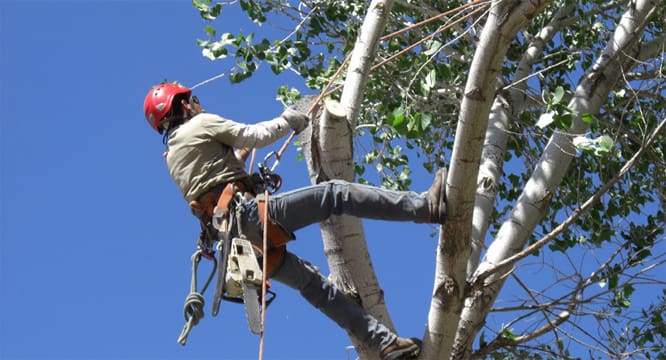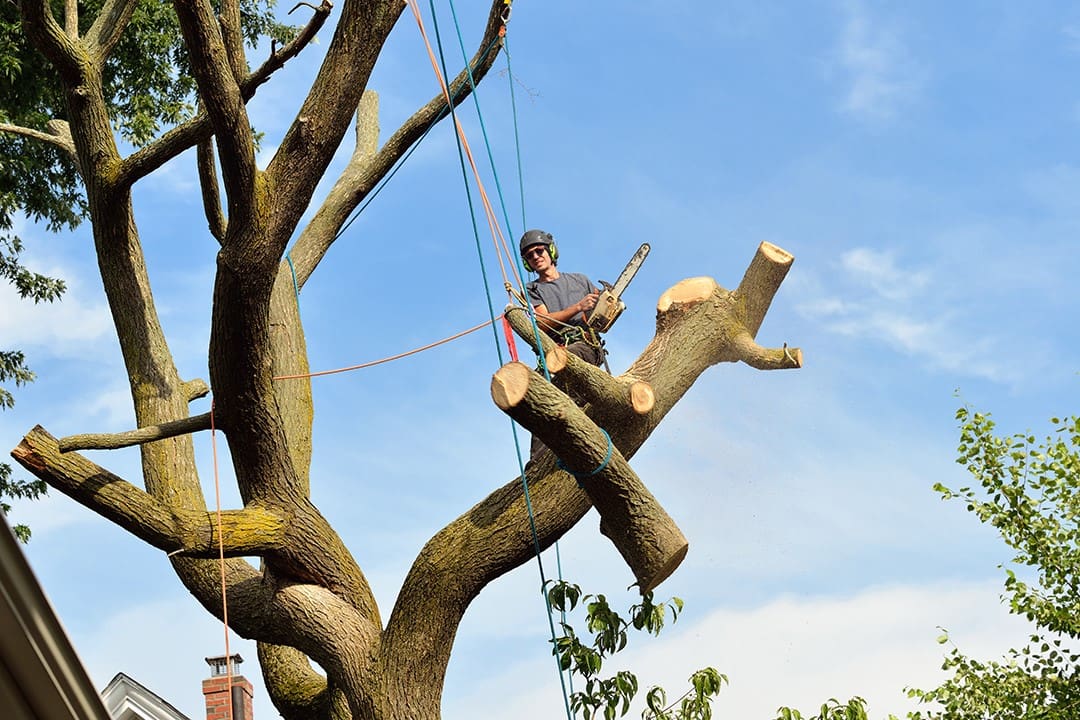Tree Removal
14 Essential Tips for Boosting Tree Growth With Healthy Soil


Hey there!
Want to know the secret to boosting tree growth? Well, I’ve got 14 essential tips that will make your trees thrive like never before.
With healthy soil as our foundation, we’ll dive into topics like soil testing, pH balance, and nutrient deficiencies.
We’ll also explore the benefits of composting, beneficial microorganisms, and soil amendments.
Plus, we’ll cover managing weeds and monitoring tree health.
Get ready to give your trees the love and care they deserve!


Soil Testing
In my experience, conducting a soil test is an essential step in optimizing tree growth and ensuring healthy soil conditions. Soil testing provides valuable information about the composition and pH levels of the soil, allowing for targeted adjustments to be made.
By understanding the specific needs of the soil, we can create a tailored plan that promotes optimal tree growth. Testing the soil also helps identify any nutrient deficiencies or excesses, enabling us to address them through appropriate fertilization techniques. This ensures that trees receive the necessary nutrients for their growth and development.
Moreover, soil testing can reveal potential issues such as soil compaction or drainage problems, which can be rectified to create a more favorable environment for tree roots.
Ultimately, soil testing is an indispensable tool in creating a thriving and healthy ecosystem for trees to flourish.
Ph Balance
As a tree enthusiast, I understand the importance of maintaining the proper pH balance in the soil for optimal growth. Acidic soil can have detrimental effects on trees, such as stunted growth and nutrient deficiencies.
On the other hand, alkaline soil can also pose challenges, but there are solutions available to help balance the pH levels and create a healthy environment for trees to thrive.
Acidic Soil Effects
With an imbalanced pH level, acidic soil can have detrimental effects on tree growth. When the soil becomes too acidic, it affects the tree’s ability to absorb essential nutrients, leading to stunted growth and weakened overall health.


Here are three key consequences of acidic soil:
- Nutrient deficiency: Acidic soil inhibits the availability of important nutrients like nitrogen, phosphorus, and potassium, which are vital for tree growth.
- Aluminum toxicity: Acidic soil releases aluminum, which becomes toxic to tree roots, impairing their ability to take up water and nutrients.
- Microbial imbalance: Acidic conditions disrupt the beneficial microbial activity in the soil, reducing nutrient cycling and impairing the tree’s ability to absorb nutrients.
Understanding the negative effects of acidic soil is crucial in finding solutions to improve tree growth. Transitioning into the subsequent section about alkaline soil solutions, we can explore methods to restore balance and create a healthier environment for trees.
Alkaline Soil Solutions
Moving forward from the discussion on the negative effects of acidic soil, let’s now explore alkaline soil solutions for achieving a balanced pH level.
Alkaline soil, with a pH level above 7, can lead to nutrient deficiencies and hinder plant growth. To address this, there are several methods to raise the pH level and create a more alkaline soil environment.
One option is to add lime, such as agricultural lime or dolomitic lime, which will neutralize the acidity and increase the pH. Another solution is to incorporate organic matter, like compost or well-rotted manure, into the soil. Organic matter helps to buffer the pH and improve the overall soil structure.
By implementing these alkaline soil solutions, gardeners and tree enthusiasts can create an optimal environment for tree growth and health.
Now, let’s move on to the next section and discuss the importance of organic matter in maintaining healthy soil.


Organic Matter
When it comes to boosting tree growth, organic matter plays a vital role in maintaining a healthy soil environment.
Soil nutrient enrichment is one of the key benefits of incorporating organic matter into the soil. By composting organic materials, such as kitchen scraps and yard waste, we can create nutrient-rich compost that improves soil quality.
Additionally, the presence of organic matter promotes microbial activity and decomposition, further enhancing the soil’s fertility and supporting tree growth.
Soil Nutrient Enrichment
I enrich the soil with organic matter to boost tree growth. Organic matter is an essential component of healthy soil, providing nutrients and improving its overall structure. Here are three key benefits of soil nutrient enrichment with organic matter:
- Increased nutrient availability: Organic matter releases essential nutrients slowly over time, ensuring a steady supply for tree growth. This helps prevent nutrient deficiencies and promotes healthy foliage and root development.
- Improved soil structure: Organic matter enhances soil structure by increasing its ability to hold water and nutrients. It also improves drainage in heavy soils and helps prevent erosion in sandy soils, creating a more favorable environment for tree roots.
- Increased microbial activity: Organic matter acts as food for beneficial soil microorganisms, such as bacteria and fungi. These microorganisms break down organic matter, releasing nutrients and promoting a healthy soil ecosystem that supports tree growth.
Composting for Healthier Soil
To further improve soil nutrient enrichment, I turn to composting as a means to enhance organic matter content. Composting is the process of decomposing organic materials, such as kitchen scraps, yard waste, and leaves, into a nutrient-rich soil amendment.
By creating a compost pile or using a composting bin, I can harness the power of decomposition to create a valuable resource for my soil. As the organic materials break down, they release essential nutrients and beneficial microbes that promote healthy plant growth. Composting also helps to improve soil structure, water retention, and aeration, creating an optimal environment for tree roots to thrive.
By incorporating compost into my soil, I’m providing a steady supply of organic matter and ensuring the long-term health of my trees.


Now, let’s delve into the fascinating world of microbial activity and decomposition.
Microbial Activity and Decomposition
By harnessing the power of microbial activity and decomposition, the organic matter in my compost enriches the soil, providing essential nutrients and creating an optimal environment for tree growth.
This process involves the breakdown of organic materials by microorganisms such as bacteria, fungi, and protozoa. These microorganisms play a vital role in nutrient cycling, releasing nutrients from organic matter and making them available to plants.
The decomposition process also helps to improve soil structure by increasing its porosity and water-holding capacity. Additionally, microbial activity in the soil promotes disease suppression, as certain microorganisms can outcompete harmful pathogens.
Nutrient Deficiencies
A tree may experience nutrient deficiencies when it lacks an adequate supply of essential minerals in the soil. These deficiencies can hinder its growth and overall health.
One common nutrient deficiency is nitrogen, which is essential for leaf and stem development. Signs of nitrogen deficiency include yellowing leaves and stunted growth.
Another important nutrient is phosphorus, which promotes root development and flowering. A tree lacking phosphorus may have weak roots and produce fewer flowers.


Potassium is yet another crucial nutrient that helps with overall tree vigor and disease resistance. Symptoms of potassium deficiency include weak branches and increased susceptibility to pests and diseases.
To address nutrient deficiencies, it’s important to conduct a soil test and amend the soil with appropriate fertilizers or organic matter. Providing the necessary nutrients will ensure healthy tree growth and vitality.
Composting
Composting is an essential practice for boosting tree growth with healthy soil. By creating nutrient-rich soil, composting provides trees with the necessary elements they need to thrive.
There are various methods of composting that can be used, such as hot composting or vermicomposting, each with its own benefits and considerations.
Incorporating organic matter through composting is crucial for maintaining soil health and promoting the overall well-being of trees.
Nutrient-Rich Soil Benefits
As a tree enthusiast, I’ve discovered the incredible benefits of nutrient-rich soil through composting. Composting is a natural process that transforms organic waste into nutrient-rich soil.
Here are three key benefits of nutrient-rich soil for tree growth:


- Increased nutrient availability: Nutrient-rich soil provides trees with essential minerals and nutrients, such as nitrogen, phosphorus, and potassium. These nutrients promote healthy growth, strong root development, and vibrant foliage.
- Improved soil structure: Compost enriches the soil by improving its structure, making it more porous and better able to retain moisture. This allows tree roots to access water and nutrients more efficiently, leading to enhanced growth and resilience.
- Enhanced microbial activity: Nutrient-rich soil supports a diverse community of beneficial microorganisms. These microbes break down organic matter, release nutrients, and create a favorable soil environment for tree roots. This symbiotic relationship boosts tree health and overall ecosystem balance.
Composting Methods Explained
I have found that one of the most effective ways to enhance nutrient-rich soil and promote tree growth is by using different composting methods.
Composting is the process of decomposing organic matter, such as kitchen scraps, yard waste, and leaves, into a nutrient-rich soil amendment.
There are several composting methods that you can choose from, depending on your space, time, and preferences.
One popular method is the traditional compost pile, where you layer organic materials and turn them regularly to promote decomposition.
If you have limited space, you can opt for a compost bin or tumbler, which helps contain the materials and speeds up the decomposition process.
Another option is vermicomposting, where worms break down the organic matter into nutrient-rich castings.
Whichever method you choose, make sure to maintain the right balance of organic materials, moisture, air circulation, and temperature to create high-quality compost that will nourish your trees and plants.


Importance of Organic Matter
One of the key factors for boosting tree growth with healthy soil is the essential role that organic matter plays. Organic matter, such as compost, provides numerous benefits to the soil ecosystem, which ultimately translates into healthier and more vibrant trees. Here are three reasons why organic matter is so important:
- Enhances soil structure: Compost improves soil structure by creating pore spaces that allow for better water infiltration and root penetration. This helps trees access essential nutrients and promotes healthy root development.
- Increases nutrient availability: Organic matter releases nutrients slowly over time, providing a steady supply of essential elements for tree growth. This reduces the risk of nutrient deficiencies and ensures that trees have access to the nutrients they need to thrive.
- Promotes beneficial microbial activity: Compost supports a diverse and thriving community of beneficial microorganisms in the soil. These microorganisms help break down organic matter further, releasing nutrients and improving soil fertility.
Mulching Techniques
When properly executed, using mulching techniques can significantly enhance tree growth by improving soil health. Mulching involves applying a layer of organic material, such as wood chips or shredded leaves, around the base of the tree. This layer acts as a protective barrier, preventing weed growth and reducing water evaporation from the soil.
Additionally, as the mulch breaks down, it releases nutrients into the soil, promoting healthy root development and overall tree growth. To effectively mulch, start by clearing any existing weeds or grass around the tree. Then, spread a layer of mulch around the base, ensuring it isn’t piled against the trunk.
Maintain a thickness of 2-4 inches and replenish the mulch as needed. By implementing proper mulching techniques, you can create a nurturing environment for your trees, leading to enhanced growth and vitality.
Watering Strategies
To ensure optimal tree growth and health, it’s important to implement effective watering strategies that complement the mulching techniques discussed previously.
Proper watering is crucial for tree survival, as it helps maintain soil moisture levels and provides essential nutrients to the roots.
Here are three key watering strategies to consider:


- Deep watering: Watering deeply and infrequently allows the roots to grow deeper into the soil, promoting stronger and more resilient trees.
- Timing: It’s best to water early in the morning or late in the evening to minimize evaporation and ensure maximum absorption.
- Mulch retention: Mulch helps retain moisture in the soil, reducing the need for frequent watering and providing a protective barrier for the roots.
By following these watering strategies, you can provide your trees with the necessary hydration for their growth and overall well-being.
Now let’s move on to the next topic: proper drainage, which is equally important for maintaining healthy soil conditions.
Proper Drainage
As I continue our exploration of boosting tree growth with healthy soil, let’s delve into the importance of proper drainage for maintaining optimal soil conditions.
Adequate drainage plays a crucial role in providing trees with the ideal environment for growth. When soil becomes waterlogged, it can lead to a lack of oxygen in the root zone, causing root rot and hindered nutrient uptake.
To ensure proper drainage, it’s essential to assess the soil’s characteristics and make necessary amendments. Sandy soils, for example, drain quickly, while clay soils retain water for longer periods. Adding organic matter, such as compost or well-rotted manure, can improve drainage in clay soils.
Additionally, installing drainage systems or creating raised beds can help redirect excess water and prevent waterlogging.
Avoiding Soil Compaction
How can I prevent soil compaction and promote healthy tree growth?


Soil compaction occurs when the soil becomes densely packed, hindering root growth and nutrient absorption. To avoid this, follow these tips:
- Use mulch: Applying a layer of organic mulch around the base of the tree helps retain moisture and prevents soil compaction caused by heavy rainfall or foot traffic.
- Limit foot traffic: Minimize walking or driving over the root zone to prevent soil compaction. Encourage visitors to stay on designated paths or use stepping stones.
- Aerate the soil: Regularly aerating the soil around the tree allows for better water infiltration and root development. Consider using a soil aerator or consulting a professional arborist for assistance.
Fertilizer Application
When it comes to fertilizing trees, timing is crucial. Different trees have different nutrient requirements, so it’s important to understand what your specific tree needs.
Timing for Fertilizers
Why should I consider the timing for fertilizer application when boosting tree growth with healthy soil? Timing is crucial because it allows the tree to receive the nutrients it needs at the right moment, maximizing its growth potential.
Here are three important reasons why timing matters:
- Seasonal nutrient requirements: Trees have different nutrient needs at different times of the year. Applying fertilizer during the active growing season ensures that the tree has access to the nutrients it requires for optimal growth.
- Avoiding nutrient loss: Applying fertilizer when the tree is dormant or during periods of heavy rainfall can lead to nutrient runoff, wasting valuable resources. By timing fertilizer application correctly, you can minimize nutrient loss and maximize its effectiveness.
- Preventing stress: Applying fertilizer during periods of stress, such as drought or extreme temperatures, can further burden the tree. Timing the application during more favorable conditions can help support the tree’s health and resilience.
Nutrient Requirements for Trees
To ensure optimal tree growth, it’s crucial to understand the specific nutrient requirements for trees when applying fertilizer.
Trees require three main nutrients: nitrogen, phosphorus, and potassium. Nitrogen is essential for leaf and stem growth, while phosphorus promotes root development and overall tree health. Potassium is important for fruit production and disease resistance.
When choosing a fertilizer, it’s important to consider the nutrient ratios listed on the packaging. For example, a 10-10-10 fertilizer contains equal parts nitrogen, phosphorus, and potassium.


However, different trees have different nutrient requirements, so it’s important to research the specific needs of your tree species. Over-fertilization can be detrimental, so it’s advisable to follow the recommended application rates and frequency.
Beneficial Microorganisms
One essential component for boosting tree growth with healthy soil is the presence of beneficial microorganisms. These microscopic organisms play a vital role in enhancing soil fertility and promoting overall tree health.
Here are three ways in which beneficial microorganisms contribute to tree growth:
- Improved nutrient availability: Beneficial microorganisms help break down organic matter in the soil, releasing essential nutrients that trees need for growth. They also form symbiotic relationships with tree roots, facilitating the absorption of nutrients like nitrogen and phosphorus.
- Disease suppression: Certain beneficial microorganisms have the ability to suppress harmful pathogens in the soil, protecting trees from diseases. They compete with and inhibit the growth of disease-causing organisms, creating a healthier environment for tree roots.
- Enhanced soil structure: Beneficial microorganisms produce substances that improve soil structure, making it more conducive to root growth and water infiltration. They help create aggregates that prevent soil compaction and enhance aeration, allowing tree roots to access oxygen and water more efficiently.
Soil Amendments
I recommend incorporating soil amendments to enhance tree growth and promote healthy soil. Soil amendments are substances that are added to the soil to improve its physical or chemical properties. They can help increase nutrient availability, improve soil structure, and enhance water retention.
Some common soil amendments include compost, manure, peat moss, and vermiculite. Compost, for example, is rich in organic matter and can provide essential nutrients to trees. Manure, on the other hand, is a good source of nitrogen, phosphorus, and potassium.
By adding these amendments to the soil, you can create a nutrient-rich environment that will support the growth and development of your trees.
Now that we’ve discussed soil amendments, let’s move on to the next section, which is about managing weeds.


Managing Weeds
How can I effectively manage weeds to promote healthy tree growth in my garden?
Managing weeds is crucial for maintaining the health and growth of your trees. Here are three important tips to help you effectively manage weeds in your garden:
- Mulching: Apply a layer of organic mulch around the base of your trees to suppress weed growth. Mulch not only helps to prevent weed seeds from germinating but also retains moisture in the soil, promotes beneficial soil organisms, and improves soil structure.
- Hand-pulling: Regularly inspect your garden for weed growth and manually remove them by pulling them out from the root. Be sure to remove the entire weed to prevent regrowth.
- Herbicides: If the weed infestation is severe, consider using herbicides. However, it’s important to choose a selective herbicide that targets specific weeds without harming your trees. Always follow the instructions and safety precautions provided by the manufacturer.
Monitoring Tree Health
To ensure optimal tree growth and well-being, monitoring the health of your trees is essential. By regularly observing and assessing your trees, you can detect early signs of disease, nutrient deficiencies, or pest infestations.
Start by inspecting the foliage for any discoloration, wilting, or unusual growth patterns. Check the bark for cracks, lesions, or signs of decay. Pay attention to the tree’s overall structure and stability, ensuring there are no leaning or broken branches.
Monitoring the soil moisture and pH levels is also crucial, as it directly affects tree health. Regularly testing the soil will help you determine if any amendments or adjustments are needed.
Additionally, keep an eye out for any insects or pests that may be damaging your trees. By closely monitoring your trees, you can promptly address any issues and ensure their long-term health and vitality.


Hello there! I’m Logan Foster, the green-thumbed social media marketer behind the vibrant world of 1800TreeGuy.com. With roots firmly planted in arboriculture, I’ve branched out to help clients cultivate their dream outdoor spaces, one leafy canopy at a time. My knack for nurturing nature is more than a profession—it’s a way of life.
When I’m not talking trees and teaching the art of arboreal care, you can find me cheering on the Bulldogs—my alma mater’s pride and my forever team. My environmental studies there didn’t just teach me about ecosystems; they instilled a lifelong passion for protecting our planet.
Off the clock, I’m an adventurer at heart. Whether it’s trekking the Appalachian trails, pedaling down a mountain path, or crafting guides to share the wonders of the wild, I’m happiest with soil under my nails and the sun on my face. And let’s not forget Yoda, my pug sidekick. He may not have mastered the art of stillness, but his joyful grins are my daily dose of happiness.
I’m all about making connections—between people and the great outdoors and between my clients and their ideal landscape visions. My approach is personal; every tree has a story, and every garden reflects its caretaker.
If you want to green your scene or share in my outdoor escapades, give me a shout on Instagram or Facebook. Let’s cultivate a conversation and grow a community rooted in a love for the lush life.







